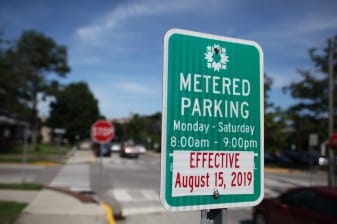Neighborhood zone parking regs could be up for more tweaks before Aug. 15

Green signs with white lettering along 6th Street, east of Washington in downtown Bloomington, alert motorists to the meter-enforcement hours: Monday through Saturday from 8 a.m. to 9 p.m.

A close look at any of the signs reveals the “8” to be a small patch—it was pasted over a “9” to blend in with the rest of the sign. The one-hour-earlier enforcement time took effect on Jan. 1 this year.
The change to meter enforcement times was one of several revisions to the city’s parking ordinance enacted by Bloomington’s city council at its Sept. 19 meeting last year, on a unanimous vote.
A more obvious, white patch covers the lower third of the signs along 6th Street. It covers up what was previously an exemption for holders of residential neighborhood zone permits—they did not have to pay the meter. As the red lettering on the patch warns, meter enforcement at those locations will apply to everyone, effective Aug. 15, 2019.
The change was prompted by the finding that metered spaces in the neighborhood zone were dominated by long-term parking permit holders. Meters are supposed to promote the kind of frequent turnover that supports retail patronage. (The overlap between neighborhood zones and metered areas is confined to 6th and 7th streets east of Washington.)
A patch to the new parking ordinance itself could be in the works, based on discussion at last Thursday’s meeting of the city’s parking commission. City council’s potential enactment of revisions by Aug. 15 would mean adhering to a deliberate timeframe, given the council’s summer recess. The next regular city council meeting falls on July 31, with work sessions set for July 19 and 26.
Details of possible tweaks might become clearer at the commission’s July 11 work session. That’s when city councilmember Steve Volan said he’d like to have something more concrete in front of the commission. Volan is an ex officio member to the parking commission, representing the city council.
Based on the commission’s discussion, among the ordinance amendments that could be considered is one that would redraw the boundaries of the newly created Zone 6. The new Zone 6 is in the Garden Hill neighborhood, west of the Indiana University football stadium. The idea would be to exclude some area around the Windfall Dancers location, in response to the dance studio’s concerns about the new zone’s effect.
Another idea spitballed at the commission’s Thursday meeting was some accommodation for nonprofits, which might respond to some of the Monroe County Public Library’s concerns about the effect that new neighborhood zone permit regulations will have on parking for its employees.

The city’s parking services director, Michelle Wahl, told the Beacon the white patches on the 6th Street signs were installed in the third week of June. She wanted to try to give some advance warning to anyone accustomed to parking there without feeding the meter.
The position of parking services director is a new one, created by one of the parking ordinance changes enacted by the city council last September. Wahl introduced herself to parking commissioners last Thursday at their regular meeting, telling them she’d been on the job since April.
Wahl also told commissioners that she’s been talking to people who will be affected by the range of revisions to neighborhood zone regulations. Besides a new meter-feeding requirement, the changes include permit fee increases and a cap on the number of permits granted annually to employees of businesses located within a prescribed area. It’s the section of downtown bounded by S. Washington Street on the west side, S. Indiana Street on the east side, and E. 3rd Street on the south side, and E. 6th Street on the north side.
The fee for permits granted to employees will increase from $75 to $103, with future incremental increases that will make the cost $138 in 2029.
The cap on residential zone permits for businesses is 40 for each of the two newly consolidated Zone 4 and Zone 5 areas. (The new Zone 4 comprises the old Zones 4 and 5. The new Zone 5 comprises the old Zones 6 and 7.) Businesses can be issued one permit per 10 employees employed by the business.
For employees of the Monroe County Public Library, the new regulations for residential zones mean a reduction from 50 total permits to 16. That means 34 library employees who could previously use a neighborhood zone permit to park on the street will need to find an alternative. And those with permits who might have parked at metered spaces will need to pay the meter.
Describing reaction from library staff to the new permit regulations, Wahl told parking commissioners, “I can’t say it got a great response…You’ll be hearing from them.”
At the July 11 parking commission work session, it might become clearer if the parking commission is willing to work on recommending any tweaks to the neighborhood permit program in response to the library’s concerns.




Comments ()